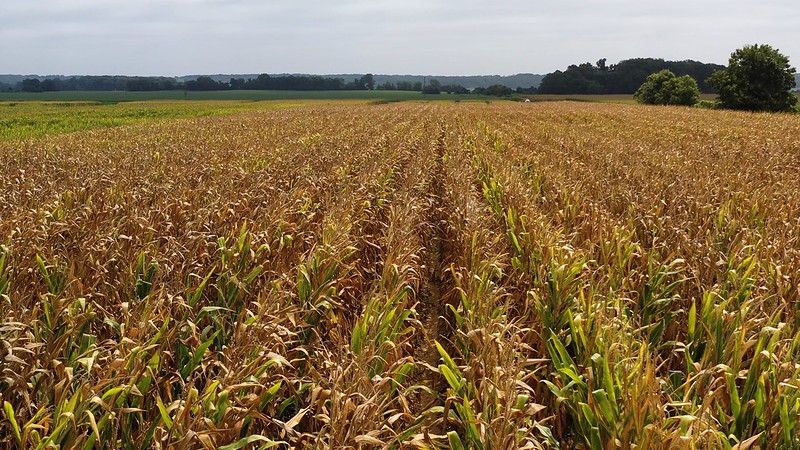Early days of rice, corn harvests near record pace
Aug. 30, 2024
By Ryan McGeeney
U of A System Division of Agriculture
Fast Facts:
- Nearly one quarter of Arkansas rice crop already harvested
- 30 percent of corn harvested
- Dropping Mississippi River levels likely present export problem
(718 words)
(Newsrooms: With art at https://flic.kr/p/2qaWAYe)
LITTLE ROCK — The first few phone calls an agronomist receives during harvest tend to say a lot about how the fall will go. For Jarrod Hardke, extension rice agronomist for the University of Arkansas System Division of Agriculture, the news has been overwhelmingly good this year.
“The frequent refrain in the phone calls I’ve been getting for the past couple of weeks is ‘You won’t believe what this rice cut!,’ and relatively little of the ‘Hey, there’s something wrong with this rice,’” Hardke said. “You can gauge the tone of the harvest pretty quickly.”
The U.S. Department of Agriculture reported Monday that 23 percent of Arkansas’ rice crop had already been harvested, dwarfing the five-year average of 4 percent typically harvested so early in the season.
Hardke said this pace hasn’t been seen since 2010.
“At this point, we’re going as fast as we can go,” he said.
Accounting for about half the rice produced in the United States, Arkansas growers this year planted more than 1.4 million acres of the crop. Hardke said growers’ efforts at early planting have put Arkansas in a good position for an early harvest with good yields.
The earliest harvest efforts occurred on the last day of July, with more producers gradually moving into their fields in early August. With few exceptions, the state has avoided the heat and moisture of 2023 that led to the repeated rewetting and drying cycles blamed for widespread low milling yields.
Hardke said that while overall grain yields seem high, he remained cautious regarding the state’s ultimate milling yields for 2024.
“One of the odd things about milling yield — even in a high milling yield year, where things turn out well, some of the early plantings can have a lower milling yield,” he said. “A quarter of the way through harvest, there’s still a long way to go. The story’s hardly written.”
Arkansas corn is also experiencing a rapid harvest, with 30 percent of the state’s 500,000 acres already harvested as of Aug. 25, according to USDA. The five-year average for this point in the season is 12 percent.
Jason Kelley, extension wheat and feed grains agronomist for the Division of Agriculture, said that like rice, early planting in the spring set Arkansas growers up to capitalize on good growing conditions throughout the summer.
“Early planting doesn’t necessarily mean an early harvest, but by the last week of April, we were 81 percent planted, versus the five-year average, which was 64 percent,” Kelley said.
“The month of May was nearly the warmest we’ve had — at or near a record,” he said. “That really sped things along. All along, I’ve felt like we were 10 days ahead of what a normal growth stage would be.”
Early spring rain events in the southern half of the state did impede early corn planting for some growers, Kelley said. Later rain events, however, precluded growers from needing to irrigate the crop as much as they often do throughout a growing season.
He said that corn, even among Arkansas’ most notable row crops, is especially temperature-driven in its development. The high heat of August, along with relatively few major rain events during the summer, helped the crop sprint toward the finish line.
“We’re at a point where a lot of growers are waiting for the corn to dry down a bit more, so they can harvest it and take it directly to the grain terminal,” Kelley said. “The only limiting factor for a lot of growers is if they’ve also got rice or soybeans to harvest.
“Harvest is going very smooth without any weather delays so far and like rice, yields overall are really good this year,” he said.
A looming obstacle that growers in Arkansas and elsewhere will still likely have to contend with is the low levels on the Mississippi River. Below a certain point, the river becomes impassable for the barges carrying grain to the Gulf of Mexico for export. Producers are then faced with the predicament of selling their grain with a discounted basis, cutting into an already narrow profit margin.
As of Aug. 29, the National Oceanic and Atmospheric Administration reported the river’s level at minus 4.3 feet, with continued drop in levels forecast. In October 2023, the river fell to a record minus 11.5 feet.
To learn about extension programs in Arkansas, contact your local Cooperative Extension Service agent or visit www.uaex.uada.edu. Follow us on X and Instagram at @AR_Extension. To learn more about Division of Agriculture research, visit the Arkansas Agricultural Experiment Station website: https://aaes.uada.edu/. Follow on X at @ArkAgResearch. To learn more about the Division of Agriculture, visit https://uada.edu/. Follow us on X at @AgInArk.
About the Division of Agriculture
The University of Arkansas System Division of Agriculture’s mission is to strengthen agriculture, communities, and families by connecting trusted research to the adoption of best practices. Through the Agricultural Experiment Station and the Cooperative Extension Service, the Division of Agriculture conducts research and extension work within the nation’s historic land grant education system.
The Division of Agriculture is one of 20 entities within the University of Arkansas System. It has offices in all 75 counties in Arkansas and faculty on five system campuses.
The University of Arkansas System Division of Agriculture offers all its Extension and Research programs to all eligible persons without regard to race, color, sex, gender identity, sexual orientation, national origin, religion, age, disability, marital or veteran status, genetic information, or any other legally protected status, and is an Affirmative Action/Equal Opportunity Employer.
# # #
Media Contact:
Ryan McGeeney
rmcgeeney@uada.edu
@Ryan_McG44
501-671-2120
